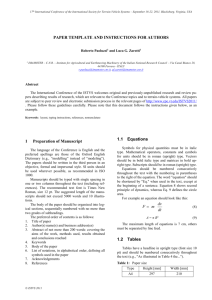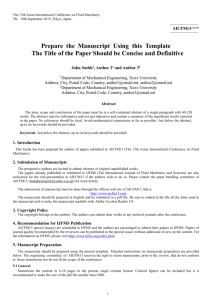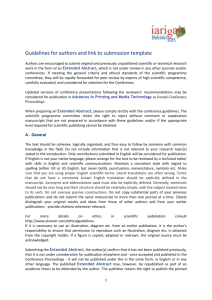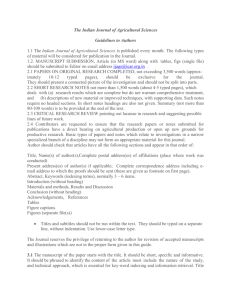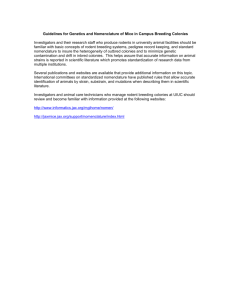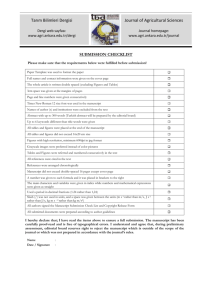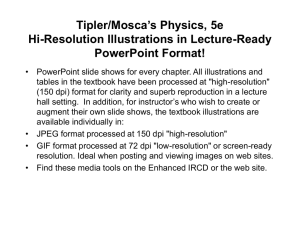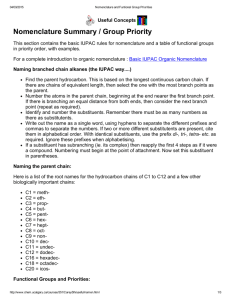International Energy Journal
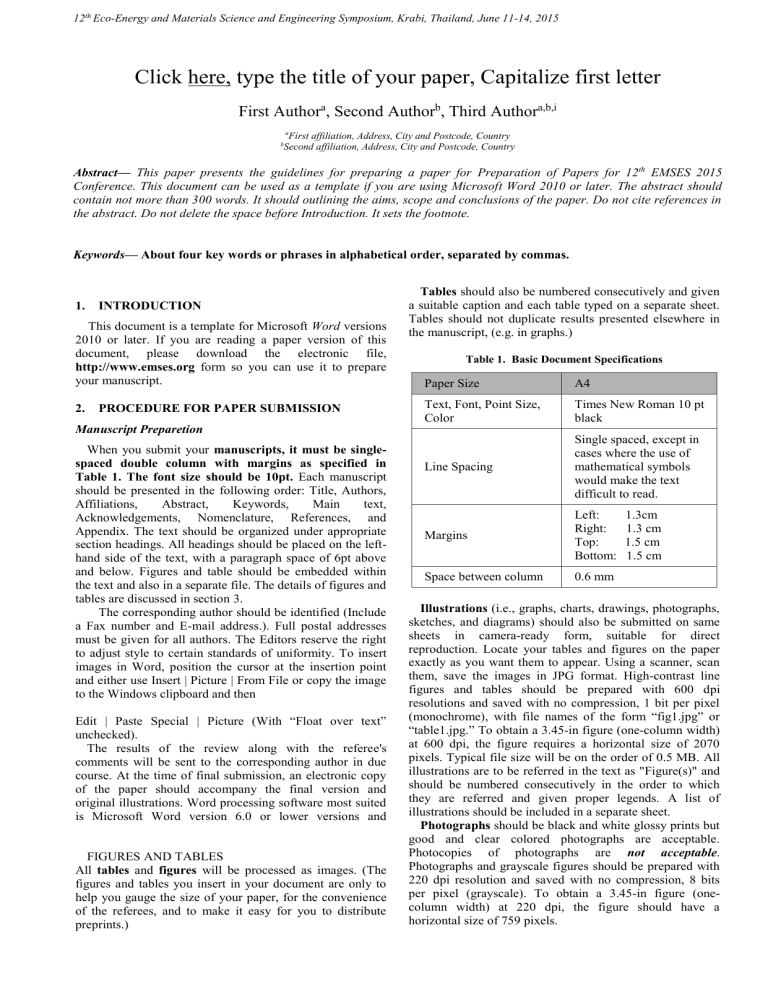
12 th Eco-Energy and Materials Science and Engineering Symposium, Krabi, Thailand, June 11-14, 2015
Click here, type the title of your paper, Capitalize first letter
First Author
a
, Second Author
b
, Third Author
a,b,i a First affiliation, Address, City and Postcode, Country b Second affiliation, Address, City and Postcode, Country
Abstract— This paper presents the guidelines for preparing a paper for Preparation of Papers for 12 th EMSES 2015
Conference. This document can be used as a template if you are using Microsoft Word 2010 or later. The abstract should contain not more than 300 words. It should outlining the aims, scope and conclusions of the paper. Do not cite references in the abstract. Do not delete the space before Introduction. It sets the footnote.
Keywords— About four key words or phrases in alphabetical order, separated by commas.
1.
INTRODUCTION
This document is a template for Microsoft Word versions
2010 or later. If you are reading a paper version of this document, please download the electronic file, http://www.emses.org
form so you can use it to prepare your manuscript.
Tables should also be numbered consecutively and given a suitable caption and each table typed on a separate sheet.
Tables should not duplicate results presented elsewhere in the manuscript, (e.g. in graphs.)
Table 1. Basic Document Specifications
2.
PROCEDURE FOR PAPER SUBMISSION
Manuscript Preparetion
When you submit your manuscripts, it must be singlespaced double column with margins as specified in
Table 1. The font size should be 10pt. Each manuscript should be presented in the following order: Title, Authors,
Affiliations, Abstract, Keywords, Main text,
Acknowledgements, Nomenclature, References, and
Appendix. The text should be organized under appropriate section headings. All headings should be placed on the lefthand side of the text, with a paragraph space of 6pt above and below. Figures and table should be embedded within the text and also in a separate file. The details of figures and tables are discussed in section 3.
The corresponding author should be identified (Include a Fax number and E-mail address.). Full postal addresses must be given for all authors. The Editors reserve the right to adjust style to certain standards of uniformity. To insert images in Word, position the cursor at the insertion point and either use Insert | Picture | From File or copy the image to the Windows clipboard and then
Edit | Paste Special | Picture (With “Float over text” unchecked).
The results of the review along with the referee's comments will be sent to the corresponding author in due course. At the time of final submission, an electronic copy of the paper should accompany the final version and original illustrations. Word processing software most suited is Microsoft Word version 6.0 or lower versions and
Pagemaker 6.5 (or lower versions).
FIGURES AND TABLES
All tables and figures will be processed as images. (The figures and tables you insert in your document are only to help you gauge the size of your paper, for the convenience of the referees, and to make it easy for you to distribute preprints.)
Paper Size
Text, Font, Point Size,
Color
Line Spacing
Margins
A4
Times New Roman 10 pt black
Single spaced, except in cases where the use of mathematical symbols would make the text difficult to read.
Left: 1.3cm
Right: 1.3 cm
Top: 1.5 cm
Bottom: 1.5 cm
Space between column 0.6 mm
Illustrations (i.e., graphs, charts, drawings, photographs, sketches, and diagrams) should also be submitted on same sheets in camera-ready form, suitable for direct reproduction. Locate your tables and figures on the paper exactly as you want them to appear. Using a scanner, scan them, save the images in JPG format. High-contrast line figures and tables should be prepared with 600 dpi resolutions and saved with no compression, 1 bit per pixel
(monochrome), with file names of the form “fig1.jpg” or
“table1.jpg.” To obtain a 3.45-in figure (one-column width) at 600 dpi, the figure requires a horizontal size of 2070 pixels. Typical file size will be on the order of 0.5 MB. All illustrations are to be referred in the text as "Figure(s)" and should be numbered consecutively in the order to which they are referred and given proper legends. A list of illustrations should be included in a separate sheet.
Photographs should be black and white glossy prints but good and clear colored photographs are acceptable.
Photocopies of photographs are not acceptable .
Photographs and grayscale figures should be prepared with
220 dpi resolution and saved with no compression, 8 bits per pixel (grayscale). To obtain a 3.45-in figure (onecolumn width) at 220 dpi, the figure should have a horizontal size of 759 pixels.
12 th Eco-Energy and Materials Science and Engineering Symposium, Krabi, Thailand, June 11-14, 2015
25.00%
20.00%
15.00%
18.08%
22.26%
IRR 0% Grant
IRR 50% grant
IRR 30% grant
IRR 70% grant
17.57%
Numbered equations should be “displayed” either by centering on the line below the text or with a standard indentation from the left margin. The equation number is usually placed so it is flush with the right margin. Put a bracket in equation number. Example:
13.17%
10.00%
8.32%
9.73% yi (t)
Fo / Ki [Ai sin(bt)
Bi cos(bt)] (1)
5.00%
5.97%
2.74%
0.00%
-0.18%
Maubesi
-5.00%
4.78%
1.61%
Oeledo
1.36%
-3.52%
-1.14%
Lim akoli
3.58%
0.83%
Nusakdale
-1.74%
6.20%
3.11%
0.28%
Daleholu
Nomenclature
Use nomenclature for explaining the equation. It will help the reader to understand.
Fig.1. IRR For Different Type of System
3.
IMPORTANT THINGS TO BE CONSIDERED
Text
The text font of the manuscript should be New Times
Roman, including that for the tables, figure labels/description and photograph captions. Font size should be 9pt as showed in Table 1. Legends, captions, labels/descriptions should use capital (upper case) letters for the FIRST LETTER of the first word only and use lower case for the rest of the words. All Greek symbols, and other symbols must be italicized and put in the nomenclature.
Nomenclature will be placed right after the Introduction.
Greek symbols should be identified the first time they appear. Do not begin a sentence with a number. A number must be written in words if it begins a sentence. If this is not practical or awkward, rephrase the sentence so it does not begin with a number.
Abbreviations should be clearly defined on first occurrence and should be used consistently throughout the text. Detailed mathematical discussion should be placed in an appendix.
Abbreviations and Acronyms
When abbreviating the names of organizations or specific terms, write the full name or term the first time it is used, followed by the abbreviation in parentheses. Example is
“All but one household had electricity and most households used liquefied petroleum gas (LPG) in all the sample urban areas. There were a relatively smaller number of households in rural areas using LPG in Thailand”
.
Abbreviations such as SI, AC, and DC do not have to be defined. Abbreviations that incorporate periods should not have spaces: write “C.N.R.S.,” not “C. N. R. S.” Do not use abbreviations in the title unless they are unavoidable (for example, “RERIC” in the title of this article).
Units and Measurements
The Standard International System of Units (SI) should be used. Consult any standard reference manual on the correct form of abbreviation for SI units. It is not necessary to place an Imperial conversion in parentheses after an SI unit as in, “The depth of the bore hole was 3.4 m
(9 ft. 18 in.).”
Mathematical Expressions
If you are using Word, use Microsoft Equation for writing equations in your paper (Insert | Object | Create
New | Microsoft Equation or MathType Equation).
4.
OTHER RECOMMENDATIONS
Use one space after periods and colons. Use a zero before decimal points: “0.50,” not “.50.” The abbreviation for
“seconds” is “s,” not “sec.” Indicate sample dimensions as
“0.2 cm
0.2 cm,” not “0.2
0.2 cm 2 .” When expressing a range of values, write “7 to 9” or “7-9,” not “7~9.”
A parenthetical statement at the end of a sentence is punctuated outside of the closing parenthesis (like this). (A parenthetical sentence is punctuated within the parentheses.) Write “do not” instead of “don’t.” The serial comma is preferred: “A, B, and C” instead of “A, B and C.”
Remember to check spelling. If your native language is not English, please get a native English-speaking colleague to proofread your paper.
5.
REFERENCES LIST
Number citations consecutively in square brackets [1].
The sentence punctuation follows the brackets [2]. Multiple references [2], [3] are each numbered with separate brackets
[1]–[3]. When citing a section in a book, please give the relevant page numbers [2]. In sentences, refer simply to the reference number, as in [3]. Do not use “Ref. [3]” or
“reference [3]” except at the beginning of a sentence:
“Reference [3] shows ....”. Type the reference list at the end of the paper using the “References” style.
Please note that the references at the end of this document are in the preferred referencing style. Give all authors’ names; do not use “ et al .” unless there are six authors or more. Use a space after authors' initials. Papers that have not been published should be cited as
“unpublished” [4]. Papers that have been submitted for publication should be cited as “submitted for publication”
[5]. Papers that have been accepted for publication, but not yet specified for an issue should be cited as “to be published” [6]. Please give affiliations and addresses for private communications.
Capitalize only the first word in a paper title, except for proper nouns and element symbols. For papers published in translation journals, please give the English citation first, followed by the original foreign-language citation.
All publications cited in the text should be presented in a list of full references in the Reference section as they appear in the text (not in alphabetical order). Typical examples of references are as follows:
6.
CONCLUSION
Conclusion should appear before the Acknowledgement.
12 th Eco-Energy and Materials Science and Engineering Symposium, Krabi, Thailand, June 11-14, 2015
ACKNOWLEDGMENT
Use the singular heading even if you have many acknowledgments. Avoid expressions such as “One of us
(S.B.A.) would like to thank ... .” Instead, write “F. A.
Author thanks ... .” Sponsor and financial support acknowledgments are placed in the unnumbered footnote on the first page .
NOMENCLATURE
Nomenclature, if needed, appears before the references list.
APPENDIX
Appendixes, if needed, appear after the references list.
REFERENCES (IMPORTANCE)
[1] Van der Geer J, Hanraads JAJ, Lupton RA. The art of writing a scientific article. J Sci Commun
2000;163:51–9.
[2] Strunk Jr W, White EB. The elements of style. 3rd ed.
New York: Macmillan; 1979.
[3] Mettam GR, Adams LB. How to prepare an electronic version of your article. In: Jones BS, Smith RZ, editors.
Introduction to the electronic age, New York: E-
Publishing Inc; 1999, p. 281–304
